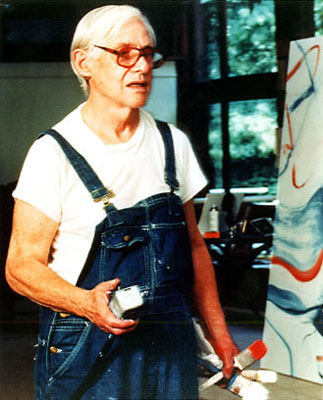The 1st
LaureatePainting
Willem de Kooning

Willem de Kooning moved from Holland to New York in his early twenties,and went on to become one of the pioneers of abstract expressionism in the immediate postwar period. His large-scale paintings with their furious brushstrokes were seen as a new and intense form of personal expression. Although abstract,his work was often rooted in the figure or landscape,linking him to the traditions of European painting. As the 1960s pop artists developed a more ironic approach to making art,de Kooning continued to expand the expressive potential of paint on canvas. His late work,less furious than before and made while he was battling a progressive illness,shows how fluid his mature painterly language had become. Many people compared him to Picasso,whose late work was equally compelling,both for his expressiveness and for the sublime quality of his painting of the human figure.
Biography
An illegal immigrant from Holland in 1926,Willem de Kooning was slow to find his place among New York painters. The son of a prosperous drinks merchant of Rotterdam and a powerful mother who owned a bar,who divorced when he was five,he found himself a disputed property between them until his mother gained custody. His apprenticeship in house painting and commercial art led on to more academic studies at the Rotterdam Academy of Fine Arts,but his career intentions did not become clear until he moved from Virginia to Manhattan in 1927 and began to associate with artists of the New York school. His key contacts in New York were John Graham (the Russian-born painter and theorist,steeped in modernism),Stuart Davis,Arshile Gorky and others who were investigating the innovations of Picasso and other Europeans to find in them the means of intense personal expression.
The uneasy but elegant figures with which de Kooning made his debut in the late thirties hover between classicism and surrealism. They led him on into fragmented figures and thence,it seemed,into full abstraction with Excavation,1950,though this too was compiled of organic forms with sensuous associations. His first solo exhibition,in 1948,established him as one of the pioneers of abstract expressionism and in 1950 he was one of the artists representing the USA at the Venice Biennale. However,in 1953 he shook American critical opinion by exhibiting his first sequence of paintings on the theme of women,which was thought to challenge the premises of the movement he had helped to establish. Dominated by monstrous images of females,these paintings were neither abstract nor sublime but,it seemed,caricatures both of femininity – so well explored by Flemish and Dutch old masters – and of expressive brushwork in the tradition of Titian and El Greco. These paintings countered the hope that ‘the new American painting’ had freed itself from European modes,and that abstract expressionism was intent on high-minded,often tragic statements. De Kooning now seemed an illegal immigrant into the movement.
Soon the vigour and commitment of his work triumphed over the fears of critics,so that de Kooning remained a leading figure beside Pollock and Rothko,admired especially for his sweeping brushwork and his sometimes fierce,sometimes shockingly sweet colours. The typical de Kooning painting appears to spring from the frantic engagement of a man with a canvas,with brushes and paints serving as cannon and grapeshot,and an imagination stirred by desire and disgust acting as gunpowder; studied coolly,it reveals a classical command of pictorial structure,both as colour and form relationships on the flat surface and in its suggestions of space,while demonstrating a mastery that links it back into the European tradition. Yet its character is ‘New World modern’,and that means urban,even when landscape replaces cityscapes and the graffiti-like woman as theme. Indeed,de Kooning’s manner and the references displayed in some of his images link him to the contemporary scene in ways which proved him more insistently attached to the present day than Rothko,Pollock and other colleagues who all liked to invoke ancient myths and primitive practices. Because of this openness to the world he has been a major influence on younger painters. His work can be seen as a precursor to art deploying commonplace imagery that was initiated by Rauschenberg and Jasper Johns in the later fifties and became pop art in the sixties. But whereas pop art’s attention to consumer products suggests a fascination bred by familiarity and even affection,de Kooning’s figures on many occasions reveal a conflict within the artist,even between the demands of art and of life. Pop art revelled in the styles of hard-sell commercialism; de Kooning held to,and dramatically enlarged,the language of paint on canvas. For about ten years from 1964,he also modelled figures for casting in bronze. Here too his aim was not representation so much as expressive and partly humorous play with the human image via the pliability of his material,clay.
As the limitations,as well as the originality and power,of the work of Rothko and Pollock (who died in 1956) became clearer,de Kooning came to be seen as the enduring hero of abstract expressionism and more particularly as the great modern painter. The late English critic David Sylvester in 1994 called him ‘the supremely painterly painter of the second half of the century and the greatest painter of the human figure since Picasso’.
Norbert Lynton
Died March 19,1997,East Hampton,New York
Chronology
-

©Willem De Kooning Revocable Trust
-

©Willem De Kooning Revocable Trust

